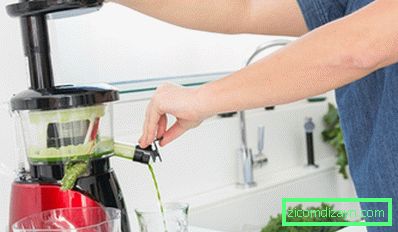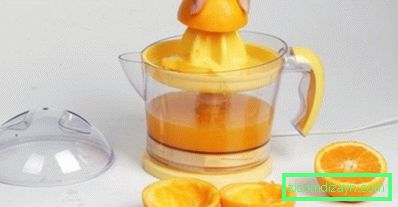Step-by-step guide for choosing a juicer
To choose the best juicer for the house you need to clearly understand what exactly you and your household need from it. After all, the ideal for all devices does not exist, and each model has its own advantages and weaknesses. In this material you will find a step-by-step guide for choosing a juicer for your home and a selection of video reviews.
Step 1. Determine the type of juicer
Type 1. Centrifugal (universal)
This is the most common type of juicers. The fruits in it are first crushed by the grater, then they enter the separator, where the juice separates from the pulp under the influence of the centrifugal force.
Pros:
- Squeezes juice from almost all fruits, vegetables and berries (except for fruit with small bones). It is especially good for soft fruits and vegetables (for example, tomatoes or peaches).
- In a cylindrical hatch you can insert small fruits entirely (eg, apples, pears, etc.), which saves time.

A universal centrifugal type juicer is a workhorse that allows you to prepare juice quickly and do not waste time chopping fruit. Just throw an apple in the neck, press it with a pusher and turn on the machine
- Juice is squeezed out very quickly - 2-4 times faster than a screw juicer.
- Juice from a centrifugal juicer is more liquid and homogeneous, without pulp (however, on the other hand, it can be called a minus, because juice with pulp is more useful).
- The machine is easy to clean even without using a special brush.
- In this category, the largest selection of devices for any budget.
- The cost of centrifugal juicers is lower than that of screw compressors. The price varies from 1000 to 12000 rubles.
Minuses:
- Due to the heating of the fruit at the stage of friction and the interaction of pulp with air in the separator, the juice oxidizes and loses some of the useful properties. In addition, this juice can not be stored for long, it should be drunk immediately.
- Squeezes juice less carefully than the screw juicer and gives 10-40% less juice (depending on the type of fruit / vegetables).
- Gives more foam in comparison with a screw model.
- Squeeze juice from herbs can only expensive models of juicers, and they cope with this not the best way, and from wheat grass - and they can not.
- It's noisy. Noise is issued about the same as from a blender, a combine or a coffee grinder.
- Centrifugal models, as a rule, are quite high and require a lot of space.
In which cases it is recommended: If you have a priority in the speed of getting juice, for example, you like to drink it for breakfast, you have a large family or you are looking for a juicer for the whole team, then a centrifugal juicer is the best choice. Also it can be recommended to fans of juices from juicy and soft fruits and vegetables, for example, tomatoes.
Tips for choosing the best universal centrifugal type juicer you can learn from this video.
Type 2. Screw (other names: "cone", "squeezer of cold pressing")
Screw juice squeezers are also universal, but they work in a different way: they squeeze juice from the fruit due to the press under high pressure, and not abrasion. The main part of the device is a conical spiral auger operating at low revs. Outwardly and by the principle of operation, the screw juicer resembles a meat grinder.

Pros:
- Preserves the maximum of useful properties of fruits, as they are not oxidized during cooking.
- For the same reason, the screw juicer allows you to make blanks and keep the juice in the refrigerator for 48 hours without losing its nutritional value. The ability to store juice in some sense compensates for the slowness of the device, because you can prepare drinks in advance.
- Squeezing is more thorough, and hence the juice it gives more.

Screw juicer is more expensive than universal, but it squeezes 10-40% more juice (depending on the juiciness of fruits / vegetables)
- Squeezes juice from almost everything, even from cabbage, seeds, nuts and grass.
- Works quietly.
- Juice is obtained with less foam (1.5-2 times compared with juice from a centrifugal machine).

Only a screw juicer is able to squeeze juice from cabbage and herbs
Minuses:
- Costs more (from 12 thousand rubles).
- The choice of devices in this category is small.
- The throat of screw juicers is smaller, so most fruits and vegetables need to be cut beforehand, which complicates and slows down the cooking process.
- Juice turns out more dense due to the presence of pulp. On the other hand, it can be said that the use of pulp compensates for the heterogeneity of the drink.
- The screw machine, although it squeezes juice from soft vegetables and fruits, but it turns out more like a mashed potatoes or baby food. However, if you have small children, then this is a great advantage.
In which cases it is recommended: The screw juicer is an ideal choice for gourmets, vegetarians, raw food, families with young children, patients who need dietary / liquid nutrition and just people who care for their health. In addition, augers are recommended for those who like juices from hard vegetables and fruits (apples, carrots, beets, etc.).
If you are interested in a screw juicer, we offer a video review and a comparison of 4 models of medium-sized screw machines.
And in this video in detail and visually presented a comparison of auger and centrifugal juicer.
Type 3. Citrus (citrus-press)
The machine is specially designed for squeezing juice from citrus. The design of electric citrus juicers is very simple and consists of: an engine, a tank for collecting juice and a cone-shaped nozzle, which, spinning at low speed, squeezes the juice from the fruit.
Pros:
- It does not require cleaning the fruit from the peel, it is enough just to wash them and cut them into halves (across the lobules). In juicers of other types, juice from citrus can also be squeezed out, but for this it is necessary to clean them beforehand.
- It can squeeze out pomegranate juice. In a screw squeezer, you can also get juice from pomegranates, but first you need to remove its grain, which is not very convenient.
- Compact.
- Inexpensive costs (the price of electric citrus presses is 1200-3000 rubles, although there are expensive models for 19-30 thousand rubles.).
- It is simple in application.
- It works fast.
- Very easy to care for.
- It does not make noise, which makes it possible to prepare juices even in the early morning, when all the households are still asleep.
- Many models of citrus machines allow you to adjust the amount of pulp in the finished juice.
Minuses:
- It is not suitable for pressing any fruit except citrus and pomegranates.
In which cases it is recommended: If apart from orange / pomegranate juice you do not need anything else, then the citrus squeezer is your choice. And even the citrus press will be very useful for fans of parties. With such a device, guests can independently squeeze juice for their cocktails, without cleaning oranges from the peel. At the same time the work of the press will not interrupt conversations, and muffle music.
If you want to buy a citrus juicer, we offer a comparative video review of three different models.
See also: 12 tips for choosing a bread maker for your home.
Step 2. Size and volume of containers
Determined with the type of juicer? Now let's think about the volume of reservoirs you need to collect juice and pulp. Citrus and centrifugal machines most often have built-in tanks for collecting pulp, and screw-type - separate (sold in the kit).
- For a couple of people, the volume of a container for collecting 300-600 ml of juice will be sufficient (this is 1-2 cups), the volume for collecting pulp is 1.5-1.6 liters.
- For a large family, to prepare juice at a time, a 1.5-2 liter reservoir is required, the volume of the pulp collecting tank is 2.6-3 liters.
Also, when choosing a suitable model, pay attention to the size of the loading throat. The wider it is, the more fruits and vegetables you can immerse into it without cutting it.
- The average size of the loading throat is 75 mm. In such a hatch will fit an apple up to 73 mm in diameter, the fruits of a larger size will have to be cut. The widest throat of the juicer may have a diameter of 84-85 mm.
Step 3. Power and speed modes
The higher the power of the machine, the faster and better it gives juice.
- For centrifugal machines the power is 250-300 W and the rotational speed of the separator is 10000-12000 rpm. To buy a device with large indicators (up to 23,000 rpm) does not make much sense, since this does not affect the productivity and quality of the juice. By the way, some juicers have up to 9 speed regimes, although in fact, an average lover of freshly squeezed juices will have 2-3 modes: a low speed mode suitable for soft fruit, and a high speed mode for solid ones. Keep in mind that some centrifugal appliances can have only 1 mode, but they are not suitable for making juices from soft fruit / vegetables.

Speed regulator
- Screw juice squeezers can have a power of 200-400 watts.
- Citrus machines have a very low power of 20-40 watts. In fact, in the selection of citrus presses, the power is not of such great importance, and a machine with a power of only 25 W will do an excellent job.
See also: Guide for choosing a mixer
Step 4. Materials of the case and parts
The housing of any juicer can be made of plastic and / or aluminum or stainless steel. Metal shells are much more beautiful and more reliable than plastic, but more expensive and heavier. Plastic, however, significantly reduces the cost of the device, makes it easier and simplifies the care for it, and with careful handling it can also last for many years.
- Keep in mind that fingerprints remain on the polished stainless steel and glossy black plastic.
The centrifuge material in the centrifugal juicer is always made of stainless steel. But the citrus and screw juice extractors can have plastic parts of the filter, because, due to low speeds, the loads on them are insignificant.
Step 5. Advanced options
It is advisable that your future juicer has the following additional options:
- Function of "drop-stop" (for machines with direct juice supply).
- Glass or jug for ready-made juice and lid-foam cutter. Well, if the juice container is measured.
- Legs-suckers or at least simple rubberized legs for stability of the device (especially important for centrifugal juicers).
- The possibility of washing removable parts in the dishwasher.
- The ability to remove the cord in a special compartment in the base of the device. Also make sure that the long or short cord is sufficient for the model you have selected.
- Brush for cleaning the sieve cells.


